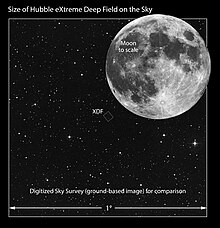Hubble Extreme Deep Field

The Hubble Extreme Deep Field ( XDF ) is an image of a small southern region of the sky that was created by stitching together images from the Hubble Space Telescope from the center of the Hubble Ultra Deep Field (HUDF) over a period of ten years. It comprises recordings of a total of 50 days and a total exposure time of two million seconds (approx. 23 days). The image was created from 2000 individual exposures that were taken by Hubble's “Advanced Camera for Surveys” (ACS) and the “Wide Field Camera 3”. It was published on September 25, 2012 and replaced the HUDF as the deepest image of the universe ever recorded in the realm of visible light . With around 5500 galaxies, the XDF contains slightly more than half the number of galaxies in the HUDF, with an area of 2.3 arc minutes × 2.0 arc minutes apparently around half as large. The light travel time from some of the galaxies shown in the picture to Earth is 13.2 billion years, the earliest galaxies shown in the picture can be seen in a stage only 450 million years after the Big Bang .
The Hubble Extreme Deep Field is in the tradition of the Hubble Deep Field , the Hubble Deep Field South and the Hubble Ultra Deep Field .
Web links
Individual evidence
- ↑ Hubble XDF fast facts
- ^ Hubble Goes to the eXtreme to Assemble Farthest-Ever View of the Universe. Retrieved September 26, 2012 .
- ↑ Hubble's Deepest View of Universe Unveils Never-Before-Seen Galaxies , NASA, August 12, 2009
